Trading Places the Ethan Brooks StoryWhether he's playing offense or defense, there's no end to the talent and persistence of this Baltimore RavenBy Kim Goss Published: Spring 2003 If you want a career in the NFL, here are five blunders you never want to make: One: Pursue your football career at a Division III College. Two: Divide your athletic life between track and football. Three: Train yourself in defense in college only to be drafted in the NFL for offense. Four: Move from offense to defense, not once but twice in your NFL career. Five: As an NFL lineman where weight and mass are critical, keep your bodyfat down to single digits. Do all this, and you can kiss your NFL career goodbye. That is, unless you’re Ethan Brooks, who made all the wrong moves and still managed to do everything right. Ethan Brooks is an offensive tackle who starts for the Baltimore Ravens. Thanks to his Wolverine-like persistence and mutant-like genetics, Brooks is the poster boy for defying the odds. His story is an inspiration for young athletes who believe that you must go to one of the college football powerhouses to make it into the NFL and that you only get one chance to make your mark. Division III Dead End The first obstacle Brooks faced as an athlete was at Westminster, a small prep high school in Simsbury, Connecticut. The major college recruiters found it easy to ignore Brooks’ accomplishments as a linebacker and then lineman at such a tiny school where his senior graduating class numbered only 49 boys. Under the circumstances, Brooks chose to attend Williams College, a Division III school in Williamstown, Massachusetts, with an enrollment of just over 2,000 students. “I wasn’t recruited by any Division I schools, and Williams was the best school I could get into,” says Brooks. “I had always dreamed of going to the NFL, but I didn’t know how realistic it was, so I just focused on getting the best education I could. I also wanted to participate in track and field, and a Division III football program wouldn’t be as demanding on my time.” Brooks, a psychology major, made time both to play football on the defensive line, establishing several school records, and to earn Division III All American honors in track. His best marks were 180 in the discus, 194 feet in the hammer, and 64 feet in the 35-pound-weight throw which gave him All-American status. Although his success in football finally drew interest from several Division I recruiters, Brooks decided to stay at Williams. “It just didn’t seem to make sense at that point. Also, I knew of a Williams player who was picked up by the Redskins just a couple years before I got to Williams, so I knew it was still possible to get into the NFL.” Possible, but not likely. Most NFL teams subscribe to one of two scouting services, BLESTO, which is based in Pittsburgh and is the oldest organization, and National Football Scouting, which is based in Tulsa. Brooks’ first evaluation, by Joe DiMarzo of the Tampa Bay Buccaneers, was on January 26, 1995. With stats that included a 5.12 forty-yard dash, Brooks, at 6’ 5.5” inches and 270 pounds, did well enough to be considered a free agent at defensive end for the 1996 NFL draft. Approximately 13 months later on his Pro Day, Brooks weighed in 22 pounds heavier and had lowered his forty time to 4.92. He also bench pressed 225 for 26 reps, vertical jumped 34 inches and long jumped 9’ 4”. Although his scores were good, Brooks was competing against Division I players who had had years of exposure playing against Division I opponents. In contrast, all Brooks’ had for evidence of his talent were films of him being double and triple-teamed against Division III players. Despite these odds, the teams testing him were impressed and he was drafted in the seventh round by the Atlanta Falcons. The catch, however, was that Brooks was being drafted as an offensive lineman. Welcome to the NFL Brooks spent the entire off-season working out as an offensive tackle, but by the second exhibition game he was moved to defensive tackle. Nevertheless, Brooks still made the final roster of 53 as a defensive tackle, although by week 10 of the regular season Brooks was again moved back to the offensive line. “It took me a while to get comfortable with the changes, and the pro game is much more competitive and so much faster” says Brooks. “But in terms of my strength level, I felt pretty good; I felt that I fit in right away.” Unfortunately, the June Jones regime that drafted Brooks in 1996 was replaced when Dan Reeves took over, and Brooks was sent to NFL Europe. Brooks’ agent, Robert McManus, was reluctant to agree to this decision because Brooks would have to postpone learning Dan Reeves’ complicated offensive system. McManus says he told the Falcon’s Personnel Director Harold Richardson, “As long as you give him an opportunity to learn the offensive system when he gets back from Europe, I will go along with this allocation.” As a result, Brooks played for the Frankfurt Galaxy at left tackle, but was then traded to Rhein Fire to play right tackle. Rhein went all the way to the World Bowl in June, and Brooks was named to the first team All NFL Europe team at right tackle This was both good news and bad. Because Rhein had gone to the World Bowl, Brooks had missed all the Falcon mini camps. Because he lacked experience with Reeves’ complex system and because the team desperately needed defensive linemen, Brooks was again moved back to defense. Once more Brooks made the final roster of 53, but after the first week of the season Brooks was released so Reeves could add an experienced defensive tackle in Shane Dronett. Fortunately, Brooks was soon picked up by the Rams to be groomed once again as an offensive tackle, and his career seemed to be back on track. He played swing tackle behind two first round picks in Orlando Pace and Wayne Gandy in 1998. With Gandy up for a new contract and the Rams not inclined to resign their starting right tackle, the 1999 right tackle job was to be Brooks’. But in June of 1999, as Brooks was preparing for his third season with the Rams, tragedy struck. His wife, Jackie, was diagnosed with non-Hodgkins Lymphoma. He decided to put his athletic career on hold for several months to help her through the trauma of chemotherapy. Brooks was subsequently released by the Rams, and he turned down offers from both the Saints, Cowboys and the Jaguars. As his wife’s health began to improve, Brooks signed with the Cardinals (over the Jaguars and the Broncos) in the 2000 season and reunited with his offensive line coach from the Rams, George Warhop. Again Brooks made the final roster; and when the starter at left tackle L.J. Shelton became injured, Brooks saw more playing time. “Shelton went down the first play of the first game, so I got to play that whole game, and then the following two games I started.” However, at the end of the season the Cardinals decided not to extend players who had missed significant amounts of practice time, as Brooks had in caring for his wife. Brooks was immediately picked up by the Broncos. In February 2001 tragedy struck again, and this time Jackie lost her battle with cancer. There would be no football for Brooks this year. “When Jackie passed away I just really wasn’t 100 percent focused on football,” says Brooks. When he was eventually able to handle his irreparable loss, Brooks knew he had a lot of work to do if he was to play again. He needed to get back in shape, and he needed to do it quickly. The Poliquin Factor Through his brother Fletcher, who is now a track and strength coach at Williams College, Brooks learned about Charles Poliquin, co-owner of the Poliquin Performance Center in Tempe, Arizona. Poliquin’s pro clients include over 60 NHL and over a dozen NFL players. “I wanted to work with Charles to get my strength levels up to a level where I could really compete on the field,” says Brooks. The results were beyond anyone’s expectations. Brooks started working with Poliquin on April 12, and continued for the next three months. He trained for one approximate |
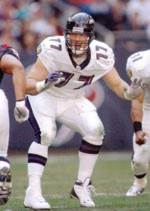 |
|
|
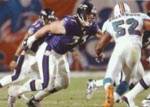 |
|
|
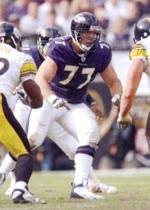 |
|
Ethan Brooks is a right tackle who starts for the Baltimore Ravens. Thanks to his Woverine-like persestence and mutant-like genetics, Brooks is the poster boy for defying the odds. |
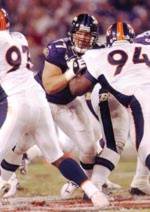 |
|
When you play opposite a perennial Pro Bow tacke such as Jonathan Ogden, you can expect your sid of the lilne to get most of the stunts and double teams. Here Brooks blocks 310-pound defensive tackle Lional Dalton. |
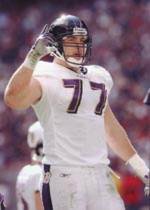 |
|
After his first year of being a consistent starter in the NFL, Brooks is now working to improve his bocddy composition and strength to play for the 2003 season. The quest to be bigger, faster and stronger is a never-ending job in the NFL. |
 |
|
Strength coach Charles Poliquin helped Brooks shatter all his personal records |
 |
|
Brooks can full squat 635, and expects to make at least 670 by training camp |
 |
|
Brooks' remarkable success with proper exercise and diet in just six weeks. Before (4-12-02) |
 |
|
After (5-27-02) |